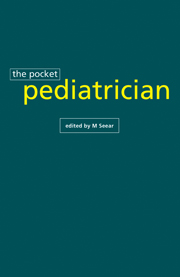Book contents
- Frontmatter
- Contents
- Analytical contents list
- Preface
- 1 Cardiology
- 2 Death and dying
- 3 Emergencies
- 4 Endocrinology
- 5 Fluids and electrolytes
- 6 Gastroenterology
- 7 General surgery
- 8 Health care ethics
- 9 Hematology
- 10 Infectious diseases
- 11 Intensive care and continuous infusion drugs
- 12 Medical genetics
- 13 Neonatology and neonatal drug dosage guidelines
- 14 Neurology
- 15 Nutrition
- 16 Oncology
- 17 Pediatric transport
- 18 Pharmacology and drug dosage guidelines
- 19 Renal
- 20 Resident fellow training
- 21 Respirology
- 22 Rheumatology
- 23 Transfusion medicine
- 24 Appendix
- Index
7 - General surgery
Published online by Cambridge University Press: 01 February 2010
- Frontmatter
- Contents
- Analytical contents list
- Preface
- 1 Cardiology
- 2 Death and dying
- 3 Emergencies
- 4 Endocrinology
- 5 Fluids and electrolytes
- 6 Gastroenterology
- 7 General surgery
- 8 Health care ethics
- 9 Hematology
- 10 Infectious diseases
- 11 Intensive care and continuous infusion drugs
- 12 Medical genetics
- 13 Neonatology and neonatal drug dosage guidelines
- 14 Neurology
- 15 Nutrition
- 16 Oncology
- 17 Pediatric transport
- 18 Pharmacology and drug dosage guidelines
- 19 Renal
- 20 Resident fellow training
- 21 Respirology
- 22 Rheumatology
- 23 Transfusion medicine
- 24 Appendix
- Index
Summary
INTRODUCTION
Pediatric general surgery deals with the unique physiology and surgical diseases of children. This involves a broad spectrum of conditions, both congenital and acquired, including soft tissue lesions, thoracic noncardiac conditions, abdominal pathology (particularly gastrointestinal) and the management of multisystem trauma. There is some overlap with urology, orthopedics and otolaryngology, plastic and reconstructive surgery.
Many conditions are congenital, and the understanding and recognition of these conditions requires a knowledge of their embryological origin. Some surgical diseases occur within certain narrow age ranges which allow for a limited differential diagnosis. The diagnosis can be made, in most cases, by the clinical history and physical examination, with often only simple investigations required for confirmation.
PREOPERATIVE CONSIDERATIONS
Anesthesia
All complex cases should be discussed with the anesthetist involved. It is unusual that the pathology is such that you cannot take a little time to correct fluid and electrolyte disorders.
Preoperative teaching
When reasonable, it is worthwhile to prepare and comfort children in advance of what to expect postoperatively. Such things as management of patient controlled analgesia (PCA) is best taught preoperatively.
Therapists involved in postoperative chest physiotherapy appreciate the opportunity to see and teach patients preoperatively.
Psychologists may be available to assist with postoperative pain management.
Nursing staff should be made aware of the types of tubes or drains that may be used and any special nursing requirements for postoperative care so that they can adequately prepare the child.
Bowel preparation
Washout
Indicated for elective colon and rectal procedures (e.g. anorectoplasty, colostomy closure, pullthrough for Hirschsprung's disease, etc.). Not indicated for small bowel surgery.
- Type
- Chapter
- Information
- The Pocket PediatricianThe BC Children's Hospital Manual, pp. 91 - 118Publisher: Cambridge University PressPrint publication year: 1996



